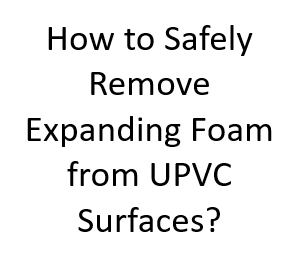Expanding foam is a versatile and effective material used for sealing gaps, insulating, and filling voids in various construction and DIY projects. While its benefits are undeniable, accidents can happen, and sometimes expanding foam might end up on unintended surfaces, such as UPVC. UPVC (Unplasticized Polyvinyl Chloride) is a common material used for windows, doors, and other exterior elements due to its durability, low maintenance, and energy efficiency. If you find yourself facing the challenge of removing expanding foam from UPVC surfaces, fear not. In this guide, we’ll walk you through the process step by step, ensuring that your UPVC surfaces remain pristine.
Understanding Expanding Foam
Before we dive into the removal process, let’s briefly understand what expanding foam is and why it can be tricky to remove from UPVC surfaces. Expanding foam, also known as polyurethane foam, is a substance that starts as a liquid and expands into a foam when it comes into contact with air. This property allows it to fill gaps and provide insulation. However, if it gets on UPVC surfaces, it can harden and adhere, making its removal a bit challenging.
Materials You’ll Need
Before you start the removal process, gather the following materials:
- Protective Gear: Safety goggles, gloves, and a face mask to protect yourself from any chemicals or debris during the removal process.
- Utility Knife: A sharp utility knife will help you carefully scrape off excess foam.
- Nail Polish Remover: Acetone-based nail polish remover can effectively break down and soften the foam.
- Plastic Scraper: A plastic scraper won’t damage the UPVC surface while removing the foam.
- Isopropyl Alcohol: This can help remove any residue left after using the nail polish remover.
- Warm Soapy Water: Mild soapy water can be used for final cleaning.
- Microfiber Cloth: For wiping and cleaning the surface.
Step-by-Step Removal Process
- Safety First: Put on your protective gear to ensure your safety throughout the process.
- Gentle Scrape: Use a utility knife to gently scrape off as much of the hardened foam as possible. Be cautious not to scratch or damage the UPVC surface.
- Nail Polish Remover: Dampen a cloth with acetone-based nail polish remover. Gently dab the foam-covered area with the cloth, allowing the nail polish remover to soften the foam. Avoid excessive rubbing, as UPVC can be sensitive to harsh chemicals.
- Scrape Again: After a few minutes, use the plastic scraper to carefully scrape off the softened foam. Work slowly and gently to avoid causing any damage.
- Repeat as Needed: Depending on the thickness of the foam layer, you might need to repeat steps 3 and 4 multiple times until you’ve removed most of the foam.
- Isopropyl Alcohol: Moisten a clean cloth with isopropyl alcohol and wipe down the area to remove any remaining residue from the nail polish remover. This will also help restore the shine of the UPVC surface.
- Final Cleaning: Mix warm soapy water and dip a microfiber cloth in it. Gently clean the area to ensure that all traces of foam and chemicals are removed.
- Rinse and Dry: Use a clean, damp cloth to rinse the area and then dry it thoroughly to prevent any moisture-related issues.
Prevention Tips
Prevention is always the best strategy. If you’re using expanding foam for a project near UPVC surfaces, consider these tips:
- Masking Tape: Cover UPVC surfaces with masking tape before using expanding foam to create a barrier.
- Precision: Use a foam gun for precise application, reducing the chances of foam overspray.
- Quick Cleanup: If expanding foam accidentally gets on UPVC, clean it as soon as possible to prevent it from hardening and adhering.
Conclusion
Removing expanding foam from UPVC surfaces requires patience, the right materials, and careful execution. By following the step-by-step process outlined in this guide, you can effectively clean expanding foam off UPVC without causing any damage. Remember to prioritize safety by wearing protective gear and taking precautions to avoid such mishaps in the future. With these tips in mind, you can confidently tackle this challenge and keep your UPVC surfaces looking their best.

